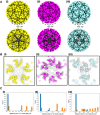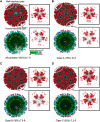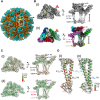Cryogenic electron microscopy and tomography reveal imperfect icosahedral symmetry in alphaviruses
- PMID: 38525304
- PMCID: PMC10959069
- DOI: 10.1093/pnasnexus/pgae102
Cryogenic electron microscopy and tomography reveal imperfect icosahedral symmetry in alphaviruses
Abstract
Alphaviruses are spherical, enveloped RNA viruses with two-layered icosahedral architecture. The structures of many alphaviruses have been studied using cryogenic electron microscopy (cryo-EM) reconstructions, which impose icosahedral symmetry on the viral particles. Using cryogenic electron tomography (cryo-ET), we revealed a polarized symmetry defect in the icosahedral lattice of Chikungunya virus (CHIKV) in situ, similar to the late budding particles, suggesting the inherent imperfect symmetry originates from the final pinch-off of assembled virions. We further demonstrated this imperfect symmetry is also present in in vitro purified CHIKV and Mayaro virus, another arthritogenic alphavirus. We employed a subparticle-based single-particle analysis protocol to circumvent the icosahedral imperfection and boosted the resolution of the structure of the CHIKV to ∼3 Å resolution, which revealed detailed molecular interactions between glycoprotein E1-E2 heterodimers in the transmembrane region and multiple lipid-like pocket factors located in a highly conserved hydrophobic pocket. This complementary use of in situ cryo-ET and single-particle cryo-EM approaches provides a more precise structural description of near-icosahedral viruses and valuable insights to guide the development of structure-based antiviral therapies against alphaviruses.
Keywords: alphavirus; cryo-EM; cryo-ET; imperfect icosahedral symmetry.
© The Author(s) 2024. Published by Oxford University Press on behalf of National Academy of Sciences.
Figures






Similar articles
-
How structural biology has changed our understanding of icosahedral viruses.J Virol. 2024 Oct 22;98(10):e0111123. doi: 10.1128/jvi.01111-23. Epub 2024 Sep 18. J Virol. 2024. PMID: 39291975 Free PMC article. Review.
-
Chikungunya virus assembly and budding visualized in situ using cryogenic electron tomography.Nat Microbiol. 2022 Aug;7(8):1270-1279. doi: 10.1038/s41564-022-01164-2. Epub 2022 Jun 30. Nat Microbiol. 2022. PMID: 35773421 Free PMC article.
-
Advances in computational approaches to structure determination of alphaviruses and flaviviruses using cryo-electron microscopy.J Struct Biol. 2023 Sep;215(3):107993. doi: 10.1016/j.jsb.2023.107993. Epub 2023 Jul 4. J Struct Biol. 2023. PMID: 37414374 Review.
-
Structures of enveloped virions determined by cryogenic electron microscopy and tomography.Adv Virus Res. 2019;105:35-71. doi: 10.1016/bs.aivir.2019.07.009. Epub 2019 Aug 20. Adv Virus Res. 2019. PMID: 31522708 Free PMC article.
-
The Alphavirus E2 Membrane-Proximal Domain Impacts Capsid Interaction and Glycoprotein Lattice Formation.J Virol. 2019 Feb 5;93(4):e01881-18. doi: 10.1128/JVI.01881-18. Print 2019 Feb 15. J Virol. 2019. PMID: 30463969 Free PMC article.
Cited by
-
Q-score as a reliability measure for protein, nucleic acid and small-molecule atomic coordinate models derived from 3DEM maps.Acta Crystallogr D Struct Biol. 2025 Aug 1;81(Pt 8):410-422. doi: 10.1107/S2059798325005923. Epub 2025 Jul 14. Acta Crystallogr D Struct Biol. 2025. PMID: 40654171 Free PMC article.
-
How structural biology has changed our understanding of icosahedral viruses.J Virol. 2024 Oct 22;98(10):e0111123. doi: 10.1128/jvi.01111-23. Epub 2024 Sep 18. J Virol. 2024. PMID: 39291975 Free PMC article. Review.
References
Grants and funding
LinkOut - more resources
Full Text Sources

